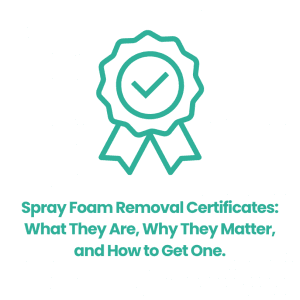Spray foam insulation may offer short-term energy efficiency, but when it starts causing moisture problems, structural concerns, or mortgage refusals, removal often becomes necessary.
At this point, many homeowners ask:
Can I remove spray foam myself, or should I hire a professional?
In this guide, we break down the different DIY methods, explain their risks, and show why manual removal by trained professionals is the only approach that’s safe, effective, and accepted by lenders.
DIY Spray Foam Removal Methods: What You Need to Know
DIY spray foam removal might seem cost-effective, but in reality, it often leads to damage, wasted time, and failed inspections. Below are the most common methods homeowners try — and the serious issues they carry.
1. Scraping & Chiselling
How It Works: Using hand tools like scrapers, chisels, or knives to chip away at the foam.
Risks:
Extremely labour-intensive
High chance of damaging roof timbers or membranes
Very slow and ineffective on dense closed-cell foam
Usually leaves behind residue that still blocks mortgage approvals
2. Chemical Solvents
How It Works: Applying acetone or citrus-based products to dissolve foam.
Risks:
Only softens foam, rarely removes it completely
Can release hazardous fumes in enclosed spaces
May cause damage to timber or insulation membranes
Not recognised as a reliable removal method by surveyors or lenders
3. Heat Guns
How It Works: Heating foam to soften it before scraping.
Risks:
Spray foam is flammable — serious fire risk
Can release toxic fumes when heated
Ineffective on closed-cell foam or larger surface areas
Creates safety hazards for homeowners and occupants
4. Power Tools (Grinders, Sanders)
How It Works: Using electric tools to grind or sand away foam.
Risks:
Creates large volumes of airborne dust
Easy to damage structural timbers or insulation materials
Hard to control over larger areas
Often leaves mess and residue, failing lender inspections
Why Professional Manual Spray Foam Removal Is the Best Option
Professional spray foam removal is not only safer and cleaner — it’s also the only method accepted by most UK lenders and surveyors.
How It Works:
Trained technicians manually remove spray foam layer by layer
Specialised tools are used to protect roof timbers and prevent damage
Dust and debris are safely contained using industrial vacuums
A clean, breathable space is left behind, suitable for re-insulation or inspection
Why We Recommend Manual Removal:
Safe for timber, tiles, membranes and structural elements
Effective on both open-cell and closed-cell foam
Fully compliant with mortgage and equity release standards
Suitable for obtaining a Spray Foam Removal Certificate
Why Use Spray Foam Advice’s Vetted Professionals?
We work with experienced UK specialists who use only manual, non-destructive techniques approved by lenders.
Our Recommended Partners Offer:
Zero risk of structural damage
No use of chemicals, heat, or dangerous tools
Quick, clean removal
Post-removal certification to help with sales, remortgages or equity release
DIY vs. Professional Removal: Quick Comparison
| Method | Effectiveness | Damage Risk | Time & Effort | Safety |
|---|---|---|---|---|
| Scraping & Chiselling | Low | High | Very slow, exhausting | Moderate risk |
| Chemical Solvents | Very low | High | Messy, slow | Unsafe in lofts |
| Heat Gun | Very low | High | Ineffective | High fire risk |
| Power Tools | Low | Very high | Very slow, messy | Dust hazard |
| Professional Manual Removal | High | Low | Fast & efficient | Safe & approved |
What To Do Next
If your spray foam insulation is affecting your ability to sell, remortgage, or refinance — don’t try to remove it yourself. The risks to your property and your safety aren’t worth it.
Instead, speak to Spray Foam Advice, and we’ll help you:
Determine if removal is necessary
Connect you with trusted removal professionals
Get your property back to a mortgageable, market-ready state
📞 Call us: 020 7870 3965
📧 Email: contact@sprayfoamadvice.co.uk
✔ Free consultation, no pressure. Just the right advice.

